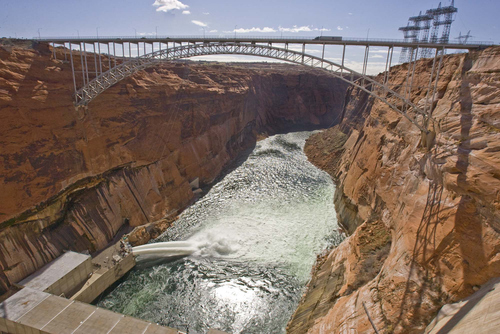This is an archived article that was published on sltrib.com in 2012, and information in the article may be outdated. It is provided only for personal research purposes and may not be reprinted.
Water supply projections are so dire in the Colorado River Basin looking 50 years into the future that some have suggested towing icebergs from the Arctic to quench the Southwest's growing thirst.
On Wednesday, the U.S. Department of Interior released a 163-page Colorado River study that projected demand for water would outstrip supply by 2060.
"This is a very significant finding," Interior Secretary Ken Salazar said Wednesday in a telephone conference call. "This study should serve as a call to action."
Utah's fortunes, however, look brighter than those of the lower Colorado Basin states of California, Arizona and Nevada that already are facing shortages, said Dennis Strong, director of the Utah Division of Water Resources.
The Beehive State has not used all the water allocated to it from the Colorado River, he said. And the 1922 Colorado River Compact protects that allocation.
"The solution [for the lower basin states] is not to take water from the upper basin," Strong said.
But the study, a three-year cooperative effort between the federal government and the seven states in the river basin, including Wyoming, Utah, Colorado, New Mexico, produced startling findings.
By 2060, the water supply in the Colorado River and its tributaries will fall at least 3.2 million acre-feet short of demand and could be as much as 8 million acre-feet less than needed. (An acre-foot is the typical amount an average suburban family uses in one year.)
Presently, the Colorado River Basin is home to 33 million people. That number is projected to grow in coming decades. But, by 2060, the study says the flows in the Colorado and its tributaries will drop 9 percent from what they are today.
The findings were based on mathematical models that include drought and climate change, according to federal officials.
There will be no "silver bullet" solution to the problem, Salazar said, citing a host of proposed actions, including conservation, re-use of storm and waste water, new plumbing efficiencies, updated land-management strategies and progressive water-rate structures.
The Interior boss added that proposals such as piping water 600 miles from the Missouri River to Denver or dragging icebergs from the Arctic to Los Angeles are not being considered.
However, desalinization may be part of the solution. The federal government operates an experimental desalinization plant in Yuma, Ariz. But critics say such a process is too expensive to be feasible.
In Utah, conservation will be the key to future water use, Strong said. Moderate water-saving strategies should guarantee enough water for municipal and agricultural uses into the foreseeable future.
Further, he noted, the study should not undermine a proposed water pipeline from Lake Powell to St. George, even though flows into and out of the reservoir behind Glen Canyon Dam will be significantly lower.
The Colorado River Basin study defined and quantified the water-shortage problem, said Pat Graham, Arizona director of the Nature Conservancy. Fortunately, he said, there is time to find solutions.
"The important thing is, diverse interests came together for this study and that's what it will take to find solutions."
Water-saving strategies implemented at local levels will be more efficient and cost less than regional solutions that tend to be large and expensive, Graham said.
"The more of those [local approaches] we get in place, the more time we buy," he said, "and the regional projects will be smaller and fewer."
Salt Lake City has demonstrated that is possible, said Jeff Niermeyer, director of public utilities.
Since 2000, the city has decreased its demand for water by 15 percent to 17 percent, he said. Those savings came from education, conservation and more efficient plumbing.
"In the future, I'm not worried that we won't have enough to drink," he said. "But we won't have the same kind of landscaping. People are already pulling up bluegrass and xeriscaping."



